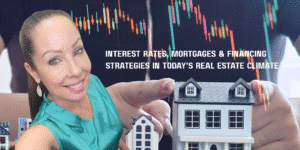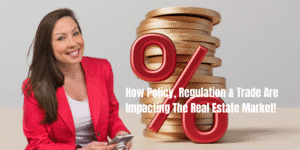
Change is in the Air: How the Investor Mindset is Shifting in Canada — and Where Smart Money Is Moving
Canada’s investing world is undergoing a quiet transformation. If you’ve been in real estate, finance, or advising clients lately, you may already feel the tectonic plates shifting. But what exactly is changing — and more importantly, where is the capital heading? Below are the major shifts + the smart money signals.
What’s Different: The New Investor Mindset
These aren’t just incremental tweaks. We’re seeing structural, mindset-level changes. Here are the biggest:
More Caution — Especially Among Institutions
Surveys show Canadian institutional investors believe the next 12 months will be more volatile than 2007-2010. That’s saying something.
Investment Executive
Concerns around macro-forces — trade protectionism, inflation, central bank policy — are driving this.
Demand for Agility & Hands-On Portfolio Management
Younger investors (and even many institutions) are less content with “set and forget” models. They’re more self-directed, more active, and less tolerant of underperformance. The old static allocation — “60/40 equities/fixed income” or whatever — is being challenged.
Greater Appetite for Private Markets & Alternatives
Private equity, private debt, infrastructure, energy transition, decarbonization — all getting more interest. Institutions are putting more dollars into sectors that were once “nice‐to‐have” or niche.
Global Diversification — Less Home Bias
Canada’s big funds are pulling more capital into US, Europe, Asia. As Canadian valuations get more stretched (or perceived as such), returns compressed, investors are looking outward. Smart money is seeing opportunity in under-exposed geographies.
Risk Awareness & Downside Protection
Not just chasing returns, but actively managing for downside. Investors are more sensitive to interest rate risk, inflation risk, geopolitical risk. And that means more hedging, more selective exposure, more emphasis on quality, yield, cashflow, stability.
ESG, decarbonization, energy transition — these aren’t just buzzwords. Many institutions are allocating real dollars with these themes in mind. We’re seeing “impact” overlayed on “return” more than before. Demographic trends (aging population, healthcare demand) are also front and centre.
Where Smart Money Is Going
So with those mindset changes, what are the directional signals? What are institutions, big pensions, high-net-worth folks doing right now or looking to do shortly?
Asset Type / Sector, Why It’s Attractive / What’s Driving It And Key Signs / Examples in Canada
Private Debt / Private Credit Higher yields vs public debt, more control over covenants, less exposure to short-term market swings. In environments of high rates and uncertainty, income + downside protection become very valuable. In surveys, about 51% of Canadian institutions plan to increase allocations to private debt over next 12 months.
Infrastructure & Energy Transition
Governments globally are pushing green investment; demand for clean energy, EV charging, renewables. Infrastructure often has long-term stable cash flows, low correlation with public markets. Northleaf capital raising large infrastructure funds; Canadian institutions broadly increasing allocations to energy transition / decarbonization projects.
International & Non-US Developed Equities Valuations in U.S. are high; expected returns are lower versus opportunities overseas. Regions like Europe, Japan, maybe parts of Asia are seen as offering better value.
Canadian ETF flows are moving to non-US developed markets, per recent data.
Small & Mid-Cap + Cyclical Exposure
When the cycle turns (or even in slowdowns), there are often outsized gains in smaller companies or in sectors like industrials, materials, etc. Strong upside potential if timed properly. Invesco’s Canadian “2025 Outlook” names small/mid-caps and value/cyclical sectors as areas of interest.
Fixed Income Tilted to High Yield / Flexible Duration
Traditional bonds (long duration) are risky when rates are volatile; high yield and bank loans offer more income and maybe a cushion. Also, more flexibility in managing duration & currency risk.
Real Assets / Real Estate (Selective Types)
Smart money is avoiding weak office assets or problematic retail; focusing instead on industrial, logistics, warehousing, senior housing, etc. Also opportunities in development vs existing assets, but with caution.
Institutional real estate reports from Canada show divestment in weaker markets/assets; strong bidding on high-quality industrial/logistics.
Responsible Investing & ESG-Adjacency
For many investors, ESG isn’t just ethical, it’s practical: companies with better ESG tend to have lower terminal downside risk, regulatory tailwinds, stakeholder goodwill. Climate risk is now investment risk.
RIA Canada’s trends show growth in responsible investment practices among asset owners/managers.
What This Means for Individual Investors (And Real Estate)
Since you work in real estate & investing, here’s what I think these shifts imply, plus opportunities you (or readers) might leverage:
Be more selective. Generic “real estate exposure” isn’t enough. Properties/assets with strong cashflows, inflation protection (e.g. leases tied to CPI), strong locations will outperform. Weak office, “just retail” in fading malls — riskier.
Think globally. There’s opportunity in real assets internationally. Some pension funds have large geographic footprints. There may be ways (REITs, international property funds) to ride that in.
Look for recurring income streams. Private debt, infrastructure, senior housing, utilities — these give steady cashflows, which become more attractive in volatile rate/inflation regimes.
Fast-moving themes are powerful. Energy transition, decarbonization, AI & tech themes, demographic shifts — these are drawing serious capital, not just fringe bets. Getting in early has upside.
Be cautious of macro risks. Policy risk (tax, regulation), interest rates, inflation, trade wars — these are front of mind for institutions. Real estate investors especially need to stress test for rising financing costs, regulatory changes (e.g. zoning, ESG rules), climate physical risks.
Leverage alternative structures. Pooled private funds, co-investments, syndications, infrastructure funds, private credit as a supplement — these offer access to what “smart money” gets, though liquidity is lower and due diligence matters more.
Predictions & Contrarian Ideas (Flagged Speculative)
Here are some speculative thoughts on where I think things could go, given these trends. Use cautiously, but worth considering.
Rise of AI- and Data-center Real Estate: We might see Canadian institutional investors allocating more into data centres, edge computing infrastructure, cloud/AI hubs (both real estate + infrastructure). These assets combine real assets + tech exposure + high demand. Could also get regulatory pushback.
“Hybrid ESG+Return” Products Becoming Mainstream: Funds that don’t force-feed ESG, but embed it in risk & return discipline are likely to attract more capital. E.g. green bonds + yield, not just green washing.
Unbundling of Real Estate: more fractional ownership, tokenization: With tech, fractional property investing and blockchain-backed ownership might become more accessible in Canada. Could open real estate investing to more people with lower capital.
More Pressure on Domestic Assets Performance: Government pressure may force pension funds to invest more in Canada, but returns domestically are under pressure. So, I anticipate more “creative domestic plays” — value-add development, repurposing existing assets, densification, mixed-use projects.
Interest Rate Surprises as Wildcards: If central banks cut too slowly, or inflation re-surges, there may be corrections. Investors who are extremely rate-sensitive (mortgages, long leases) could be caught off guard.
What To Watch Going Forward
To stay ahead, keep tabs on:
ETFs & Flow Data — where money is moving is one of the clearest signals.
Institutional survey results (RIA, Schroders, CoreData etc.) — they show what large pools are planning.
Policy shifts — foreign investment rules, climate/regulation, infrastructure policy (grants, subsidies).
Interest rate & inflation trajectory — small changes matter.
Real-asset yield spreads — gap between public assets vs private/infrastructure etc.
Valuations in different geographies / sectors — cheap vs expensive markets will attract more allocation.
Investing in Canada (and globally) is becoming less about just picking winners, more about picking where money will go when others get nervous. The smartest capital right now isn’t just chasing upside — it’s anticipating risk, choosing income plus growth, nodding to ESG and themes, and being nimble.
If you can help your clients or readers understand where institutions are leaning, you get the edge: not always in what’s obvious — but in what’s next.










